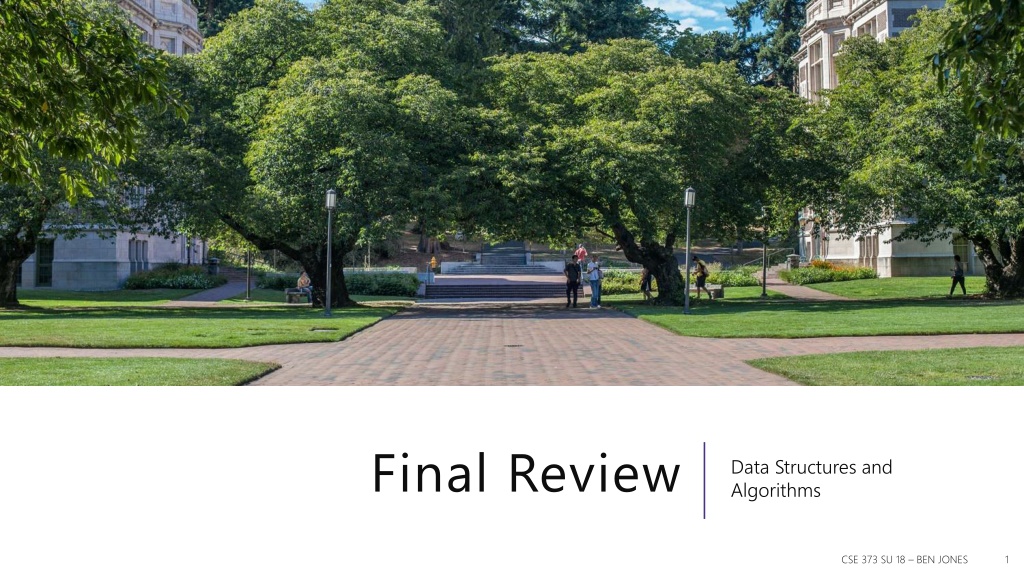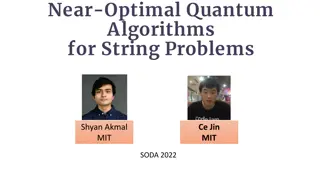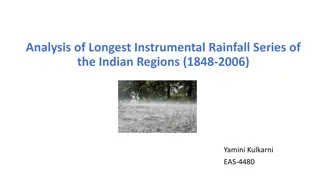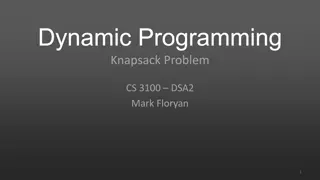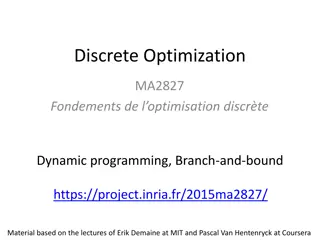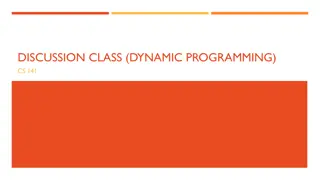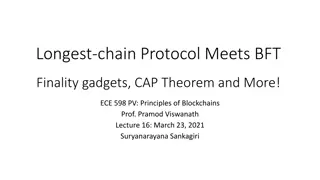Dynamic Programming for Longest Palindromic Subsequence Algorithm
This content covers the topic of dynamic programming for finding the longest palindromic subsequence in a given string. It provides information on how to approach the problem, define the recurrence relation, establish base cases, and determine the order of solving subproblems. The discussion includes examples and explanations to help understand the algorithm better.
Download Presentation

Please find below an Image/Link to download the presentation.
The content on the website is provided AS IS for your information and personal use only. It may not be sold, licensed, or shared on other websites without obtaining consent from the author. Download presentation by click this link. If you encounter any issues during the download, it is possible that the publisher has removed the file from their server.
E N D
Presentation Transcript
Final Review Data Structures and Algorithms CSE 373 SU 18 BEN JONES 1
Announcements Final Review Due Tonight Don t stress too much about it! Final on Friday 1 page of notes is allowed Course evaluations due tomorrow night. (see e-mail) Please fill out the survey on Kendra Yourtee s talk, and sign her thank-you card! CSE 373 SU 18 BEN JONES 2
Dynamic Programming Subsequence Subsequence palindrome: Given a string S, find the longest subsequence subsequence that is a palindrome. RACECAR RACECAR RA RAD DCEC CECX XAR AR Unlike your homework, the letters don t need to be consecutive! CSE 373 SU 18 BEN JONES 3
Dynamic Programming Let OPT(i, n) denote the length of the longest palindrome subsequence in the substring of length n starting at index i. Write an expression for the recursive case of OPT(i, n). CSE 373 SU 18 BEN JONES 4
Dynamic Programming Let OPT(i, n) denote the length of the longest palindrome subsequence in the substring of length n starting at index i. Write an expression for the recursive case of OPT(i, n). 2 + ??? ? + 1,? 2 , ? ? = ?[? + ? 1] max{??? ?,? 1 ,???(? + 1,? 1), ?? ?????? ??? ?,? = CSE 373 SU 18 BEN JONES 5
Dynamic Programming Next we need a base case for our OPT recurrence. Write an expression for the base case(s) of this recurrence. CSE 373 SU 18 BEN JONES 6
Dynamic Programming Next we need a base case for our OPT recurrence. Write an expression for the base case(s) of this recurrence. ??? ?,0 = 0 ??? ?,1 = 1 CSE 373 SU 18 BEN JONES 7
Dynamic Programming Now that we have a complete recurrence, we need to figure out which order to solve the subproblems in. Which subproblems does the recursive case OPT(i, n) require to be calculated before it can be solved? ??? ? + 1,? 2 ,??? ?,? 1 ,???(? + 1,? 1) CSE 373 SU 18 BEN JONES 8
Dynamic Programming Given these dependencies, what order should we loop over the subproblem in? CSE 373 SU 18 BEN JONES 9
Dynamic Programming Given these dependencies, what order should we loop over the subproblem in? Since we depend on OPT(i+1, n n- -2 2), OPT(i, n n- -1 1), and OPT(i+1,n n- -1 1) it is sufficient to have solved all subproblems with smaller n first (i.e. the subproblem for strings of shorter length). Therefore we can loop over the subproblems in order of increasing length (the order of i does not matter). CSE 373 SU 18 BEN JONES 10
Dynamic Programming We have all of the pieces required to put together a dynamic program now. Write psuedocode for the dynamic program that computes the length of the longest palindromic subsequence of S. CSE 373 SU 18 BEN JONES 11
Dynamic Programming We have all of the pieces required to put together a dynamic program now. Write psuedocode for the dynamic program that computes the length of the longest palindromic subsequence of S. Initialize OPT[S.length][S.length+1] with 0s for all OPT[i][0] and 1s for all OPT[i][1] for n from 2 to S.length: for i from 0 to S.length n: if (S[i] == S[i + n 1]): OPT[i][n] = 2 + OPT[i+1][n-2] OPT[i][n] = max( OPT[i][n], OPT[i+1][n-1], OPT[i, n-1] ) return OPT[0][S.length] CSE 373 SU 18 BEN JONES 12
Differences from Your HW Review In the HW, there is an extra constraint that the palindrome is consecutive. You ll need an extra condition to account for this. CSE 373 SU 18 BEN JONES 13
Sorting A store stocks its cereal boxes in alphabetical order along the shelf from left to right. One day, a customer picks up a few boxes, and puts them back in the wrong positions. Which sorting algorithm would be best for the store to use to put the cereal isle back in order? CSE 373 SU 18 BEN JONES 14
Sorting A store stocks its cereal boxes in alphabetical order along the shelf from left to right. One day, a customer picks up a few boxes, and puts them back in the wrong positions. Which sorting algorithm would be best for the store to use to put the cereal isle back in order? Assumptions: a) The store doesn t have an empty shelf elsewhere to sort into. - We want an in-place sort b) Only a few boxes were misplaced. The shelf is mostly sorted only a few out-of-place. - We want a sort that has a fast best-case time when the list is mostly sorted. Insertion sort has both of these properties! CSE 373 SU 18 BEN JONES 15
Topological Sort For each graph, give the topological sorting, or if there is none, why? B C A B C A D E F D E F B C A B C A D E F D E F CSE 373 SU 18 BEN JONES 16
MST Prims Algorithm Vertex Vertex Known? Known? Cost (d) Cost (d) Parent Parent A 2 4 B C A B 1 2 1 3 4 C D D E F 2 1 E F CSE 373 SU 18 BEN JONES 17
Graph Traversals (DFS) Perform a DFS from vertex G. Visit neighbors in alphabetical order. Show your work. B C A D E F G H I CSE 373 SU 18 BEN JONES 18
Graph Traversals (BFS) Perform a BFS from vertex G. Visit neighbors in alphabetical order. Show your work. B C A D E F G H I CSE 373 SU 18 BEN JONES 19
